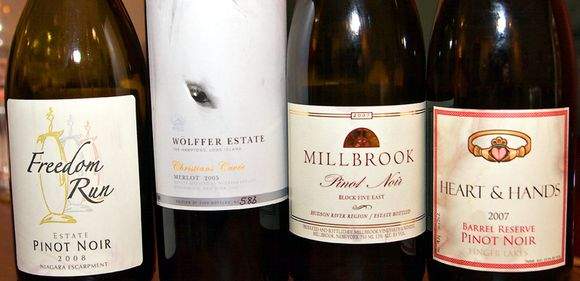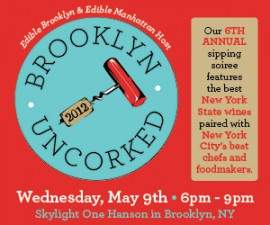Pinot Noir in New York: It Takes Location, Expression and Passion

3 Pinot Noirs and 1 Merlot: The New York Cork Report 2009 Red Wines of the Year
By Lenn Thompson, Editor-in-Chief
Photos by Morgan Dawson Photography
Is pinot noir the next great red for upstate New York?
Given how difficult pinot noir is to work with in the vineyard — especially in cool-climate regions like New York — as well as in the cellar, it may seem a silly, easy-to-answer question. But the New York Cork Report Wines of the Year tasting back in January resulted in pinot noir winning three out of four regional flights.
Merlot taking the Long Island flight wasn't a surprise, but I think we were all surprised that pinot noir won the other three. Where was cabernet franc, a grape that shows well consistently across all regions?
 The fact that these pinot noirs won in head-to-head flights against grapes like cabernet franc, cabernet sauvignon and red blends speaks even more highly to their quality. These heavier "bigger" wines tend to stand out in tastings such as these.
The fact that these pinot noirs won in head-to-head flights against grapes like cabernet franc, cabernet sauvignon and red blends speaks even more highly to their quality. These heavier "bigger" wines tend to stand out in tastings such as these.
That didn't and doesn't matter though. Pinot noir won the day. Not only can pinot noir be done in New York state, it can be done very very well. But it's not easy.
But just what does it take to make top-flight pinot in New York? As I spoke and emailed with winemakers and winery owners, three key themes themes emerged.
Location Leads
Almost every person I spoke to highlighted vineyard location as one of the most important factors in pinot success. You can't just plant pinot anywhere and expect great things. It's too tender and too fickle.
But, it's not just about location. What you do in the best locations matters just as much.
Morten Hallgren, winemaker and co-owner of Ravines Wine Cellars puts it this way "The challenges with pinot noir in the Finger Lakes
or elsewhere can be found almost entirely in the vineyard. (You need)
suitable, well-drained sites, good clones and rootstock, severe pruning
— closer to one cluster per shoot than two — an impeccable spray
program to get sufficient hang time and to bring in pinot noir free
of Botrytis, hand picking only, careful fruit handling — no crushing
or must pumps — extract early but don't over-extract, separate seeds
from skins at press time, and restrained use of good French oak."
He makes it sound easy, doesn't he? Okay, maybe not. But we already knew that going in.
On Long Island, veteran winemaker Rich Olsen-Harbich of Raphael thinks that Long Island's late summer and early fall temperatures might be too warm for pinot noir, which does better when it ripens very slowly, a sentiment echoed by Hallgren, "It really does not handle heat and drought stress very well. "
Olsen-Harbich adds however, "That being said, I do believe that there are good sites on Long Island for pinot noir. I think the potential is huge but it needs to be planted on the absolute best sites."
And much like Hallgren, Olsen-Harbich is quick to point out that success with the grape takes more than just a good site. "It takes a tremendous amount of dedication to the variety and its needs. If you want it to perform like other varieties you'll be disappointed. I'm not going to say you need high-density plantings as I'm not convinced that this is as important a factor as many people make it out to be. What is important is that the proper trellising system be designed for the specific area the vines are growing in. That will take time to figure out. But extreme crop control, good exposure and vine balance, intense selection at harvest and careful cellar handling are very important in my view."
Long Island winemakers are still trying to figure out exactly how to succeed with pinot. Osprey's Dominion Vineyards' winemaker Adam Suprenant — who makes one of my favorite local pinots, by the way — says that "Pinot noir is the holy grail of Long Island red winemaking. So many, including myself, over the past dozen years, have gone on the quest but have ended up failing to make decent red wine out of pinot noir." He also points to reduced crop loads, noting "1.5 - 1.75 tons per acre" as the sweet spot.
Jamesport Vineyards planted its pinot noir vineyard on the North Fork in 1984, so it has some of the most mature pinot noir vines in the state. But owner Ron Goerler doesn't focus on tonnage as much as some others I spoke with, instead pointing to shoot positioning, the timing of leaf removal "and having people in the winery who want to make really good pinot noir." With regard to tonnage, he told me "We believe that it takes the same amount of energy for one ton as it does for three tons."
Let the Grapes Express Themselves
Most any emerging wine region — New York and its sub-regions included — struggles at some point to make its own wines rather than ones that are "like" another region's. On Long Island, you used to hear marketers scream "We're like Bordeaux" even though it was never true and never will be. Similarly, some Finger Lakes producers compare their Rieslings to the Mosel or Alsace — classic Riesling regions to be sure, but nothing like the wines from along the lakes.
The most successful New York pinot doesn’t try to be carbon copies of the world's two dominant pinot styles: Burgundy and California.
Hallgren doesn't try to emulate either, though he thinks the best Finger Lakes pinots share characteristics with Burgundy. He approaches his wines "With a respect of the (variety's) character. This means not being obsessed with color, alcohol level or blindly imitating styles or practices found in very different regions."
But what happens when people come into the Ravines tasting room expecting plush, California-style pinot?
"When I hear the question 'Should you really grow pinot noir in the Finger Lakes?' my answer is 'Should you really grow it anywhere else in North America?' As long as classic Burgundy pinot noir remains the reference wine, there is absolutely no doubt that the Finger Lakes is the best home for pinot noir. If you want to produce alcoholic, jammy wine that resembles syrah or cabernet, then the answer would be different."
A regional style — on the New York state or AVA level — has yet to emerge. And, in the Finger Lakes at least, the pinot noir clones planted are partly to blame for inconsistent quality and they lack of a signature style.
"The difference in clonal selection is probably one of the more dramatic differences on color and density (amongst Finger Lakes pinot)," according to Tom Higgins, co-owner and winemaker at Heart & Hands Wine Company, a pinot-focused winery on Cayuga Lake. "Back in the 1980s and early 1990s growers in the Finger Lakes really didn’t care much about the clones — they just wanted to make pinot noir as part of their winery portfolio. Fortunately, in the late 1990s and into the new decade, Finger Lakes growers began planting/re-planting some of their Pinot blocks with the Dijon clones for that desired weight in the glass."
Pinot Takes Passion
Most of the pinot lovers I know are absolutely fanatical about it, but Higgins thinks that for many, it goes well beyond that. "To pursue pinot, you have to be nuts."
I'd of course hesitate to call Higgins or anyone else making pinot nuts, but in a region famous for its aromatic whites, Heart & Hands is clearly clearing its own path, or as Higgins himself puts it "I don't think anyone else has stuck themselves out so much in this way in the Finger Lakes, going against the wine-for-all model."
Clearly, Higgins is just the type of person who should be making pinot noir in the Finger Lakes. I think Hallgren would agree. He told me that "Wineries in the Finger Lakes should not consider making pinot noir unless they are willing to show a full commitment from vineyard to the winemaking to even selling it as a cool-climate style of red wine, which is not so easy these days."
Location. Expression. Passion. Those are the three keys to making good — or even great — pinot noir in New York State. And while what each means may vary from person to person, there's no arguing that New York wineries are making increasingly good pinot noir as they identify the best sites and fine tune practices both in the vineyard and in the winery.
It's a good time to be a pinot noir lover in New York.

















Lenn,
Great post!
I have to say I am not well schooled in Pinot Noir. But this article has stirred my interest in this grape.
I do have that bottle of Freedom Run, from the NYCC waiting to be opened…which will be soon.
Now I wish the Taste Live event this month was sooner, so I could get a better handle on this grape.
Lenn, this was a great post. I think you said it very well indeed when you conclude “Location, expression, passion.”
This is the “story” of Pinot Noir in a nutshell. For a millenia now it has been known that the Cote d’Or is the best location, it gives the archetype expression, and without passion it would prove to be the most disappointing region in the world - if it didn’t reach the sky in quality a couple of times a decade!
Pinot Noir is extremely personal. If you are a studied wine drinker, Pinot Noir can please you in a very deep and meaningful way even when it “fails” to live up to expectations. It’s flaws are part and parcel its very character. Pinots are an intellectual exercise, rarely a hedonistic one.
The $10 mass-production kind, are the real failures to me. They lack the passion of a winemaker, the terrior of a specific location, and ooze lifeless flawlessness. They are somewhere between silicon enhancements and white bread.
The FLX as a Pinot Noir growing region seems a very noble thing to fight for, requiring passionate people. It seems they’re already there.
Location, location, location.
I don’t think making pinot noir in the winery is that much harder than the other red grapes in the region. It’s just that everything you do to it is amplified and there isn’t much room for error.
Growing pinot is another story..its easy to ripen but not easy to keep disease free.
I’m not completely sold on tons per acre as well (under 3 tons at least). I’ve tasted great over-cropped pinot on appropriate soil, and I’ve had uninspired under-cropped pinot on other soils.
I’m def not sold that “As long as classic Burgundy pinot noir remains the reference wine, there is absolutely no doubt that the Finger Lakes is the best home for pinot noir”.
As more and more winemakers get their hands on healthy Niagara Escarpment grapes, I see that AVA becoming the home for the most Burgundian pinot noir in the state. I truly did not believe this or even want to believe that when I moved here, but I’ve seen enough and tasted enough to know that the clay and limestone soil here just works.
While the number of wineries here making pinot is still small making it difficult to taste Niagara Escarpment versions, a trip across the border to Le Clos Jordanne, Tawse or Flat Rock Cellars are great examples of what established wineries are doing with escarpment pinot noir.